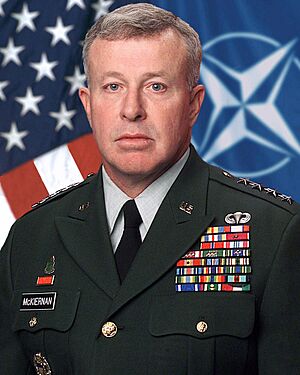David D. McKiernan facts for kids
Quick facts for kids
David D. McKiernan
|
|
|---|---|
 |
|
| Born | 11 December 1950 Atlanta, Georgia, United States |
| Allegiance | United States |
| Service/ |
United States Army |
| Years of service | 1972–2009 |
| Rank | General |
| Commands held | International Security Assistance Force United States Forces – Afghanistan Seventh United States Army Third United States Army Coalition Forces Land Component Command 1st Cavalry Division 1st Brigade, 1st Cavalry Division 1st Battalion, 35th Armored Regiment |
| Battles/wars | Gulf War Iraq War War in Afghanistan |
| Awards | Defense Distinguished Service Medal (2) Army Distinguished Service Medal (3) Defense Superior Service Medal Legion of Merit (3) Bronze Star Medal |
David D. McKiernan was a very important general in the United States Army. He was a "four-star general," which is the highest rank an officer can reach. General McKiernan was born on December 11, 1950.
He led soldiers in many important missions. For example, he was in charge of the International Security Assistance Force (ISAF) in Afghanistan. This group worked to help bring peace and safety to Afghanistan. He also led United States forces there from October 2008 to June 2009.
Before his time in Afghanistan, General McKiernan was in charge of the United States Army in Europe. He also led all the ground forces for the allied countries during the 2003 invasion of Iraq. He retired from the Army in 2009 after a long and distinguished career.
Contents
Becoming a Leader in the Army
General McKiernan studied history at the College of William & Mary. He earned his degree in 1972. After college, he joined the Army as an "Armor officer." This means he worked with tanks and armored vehicles.
He also continued his education, earning a Master's degree from Shippensburg University. Later, his first college, William & Mary, gave him an honorary doctorate for his public service.
What Commands Did General McKiernan Hold?
General McKiernan led many different groups of soldiers throughout his career. Here are some of the important commands he held:
- 1st Battalion, 35th Armored Regiment (1988–1990)
- 1st Brigade, 1st Cavalry Division (1993–1995)
- 1st Cavalry Division (1999–2001)
- Third United States Army and Combined Forces Land Component Command (2002–2004)
- Seventh United States Army and United States Army Europe (2005–2008)
- International Security Assistance Force (ISAF) and United States Forces – Afghanistan (2008–2009)
Experience in Different Regions
General McKiernan gained a lot of experience in different parts of the world. In the 1990s, he worked in the Balkans. This area had many conflicts at the time. He helped with military operations in places like Bosnia-Herzegovina, Albania, and Kosovo.
He also served during the Gulf War. This was his first time working closely with soldiers from other countries. This experience helped him prepare for future leadership roles.
Leading Forces in Iraq
In 2002, General McKiernan took command of the Third United States Army. He became the main ground forces commander for the United States and its allies. This was in preparation for Operation Iraqi Freedom.
In March 2003, General McKiernan led all the ground forces that went into Iraq. Their mission was to remove Saddam Hussein from power. After this mission, he became the Deputy Commanding General for United States Army Forces Command. This is the largest command in the Army, responsible for getting soldiers ready for deployment.
Different Views on Troop Needs
During the Iraq War, there were sometimes different ideas about how many soldiers were needed. General McKiernan had a plan that asked for more ground troops. This plan was called COBRA II.
He also saw some groups of fighters in Iraq as a big threat. However, his superior, General Tommy Franks, had a different view on how important these groups were. After the main fighting, General McKiernan was not given command of the post-war operations in Iraq. This role went to another general.
Working with Allies
In 2008, General McKiernan was asked about working with different countries, like Germany, in Afghanistan. Some countries had rules about what their soldiers could do. General McKiernan understood that each country had its own laws.
However, as a soldier, he believed that soldiers should always have the full ability to protect themselves. He felt it was important to use information to stop threats and keep soldiers safe. This is how you help soldiers stay alive.
Awards and Honors
General McKiernan received many awards and decorations for his service. These show his bravery and dedication to his country. Some of his notable awards include:
- Defense Distinguished Service Medal (with one oak leaf cluster)
- Army Distinguished Service Medal (with two oak leaf clusters)
- Defense Superior Service Medal
- Legion of Merit (with two oak leaf clusters)
- Bronze Star Medal
- Defense Meritorious Service Medal
- Meritorious Service Medal (with three oak leaf clusters)
- Army Commendation Medal (with three oak leaf clusters)
- Army Achievement Medal (with two oak leaf clusters)
He also earned special badges like the Parachutist Badge (United States) and the Ranger Tab. These show he completed tough training.

